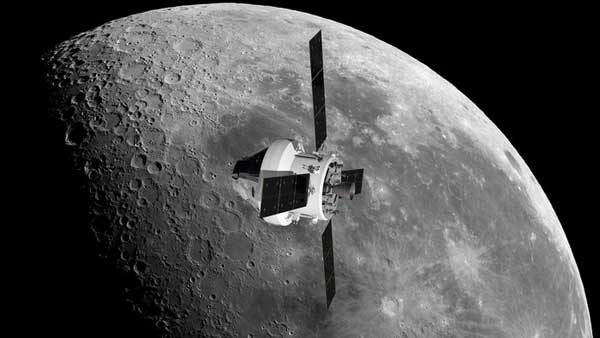
Artemis I Mission Availability Dates (Image Credit: Payload)

KENNEDY SPACE CENTER, Fla. (NASA PR) — When Artemis I is ready to launch, a range of personnel from NASA, industry, and several international partners will be poised to support the mission. Before they get to launch day, the alignment of the Earth and Moon will determine when the Space Launch System (SLS) rocket with the uncrewed Orion spacecraft atop it can launch, along with several criteria for rocket and spacecraft performance.
To determine potential launch dates, engineers identified key constraints required to accomplish the mission and keep the spacecraft safe. The resulting launch periods are the days or weeks where the spacecraft and rocket can meet mission objectives. These launch periods account for the complex orbital mechanics involved in launching on a precise trajectory toward the Moon while the Earth is rotating on its axis and the Moon is orbiting Earth each month in its lunar cycle. This results in a pattern of approximately two weeks of launch opportunities, followed by two weeks without launch opportunities.
There are four primary parameters that dictate launch availability within these periods. These key constraints are unique to the Artemis I mission and future launch availability beyond this flight will be determined based on capabilities and trajectories unique to each mission.
- The launch day must account for the Moon’s position in its lunar cycle so that the SLS rocket’s upper stage can time the trans-lunar injection burn with enough performance to successfully intercept the “on ramp” for the lunar distant retrograde orbit. The more powerful Exploration Upper Stage on future configurations of the rocket will enable daily, or near-daily, launch opportunities to the Moon, depending on the orbit desired.
- The resulting trajectory for a given day must ensure Orion is not in darkness for more than 90 minutes at a time so that the solar array wings can receive and convert sunlight to electricity and the spacecraft can maintain an optimal temperature range. Mission planners eliminate potential launch dates that would send Orion into extended eclipses during the flight. This constraint requires knowledge of the Earth, Moon, and Sun along the planned mission trajectory path before the mission ever occurs, as well as an understanding of the Orion spacecraft’s battery state of charge before entering an eclipse.
- The launch date must support a trajectory that allows for the skip entry technique planned during Orion’s return to Earth. A skip entry is a maneuver in which the spacecraft dips into the upper part of Earth’s atmosphere and use that atmosphere, along with the lift of the capsule, to simultaneously slow down and skip back out of the atmosphere, then reenter for final descent and splashdown. The technique allows engineers to pinpoint Orion’s splashdown location and on future missions will help lower the aerodynamic breaking loads astronauts inside the spacecraft will experience, and maintain the spacecraft’s structural loads within design limits.
- The launch date must support daylight conditions for Orion’s splashdown to initially assist recovery personnel when they locate, secure, and retrieve the spacecraft from the Pacific Ocean.
The periods below show launch availability through the end of 2022. Mission planners refine the periods based on updated analysis approximately two months before they begin and are subject to change.
July 26 – August 10
- 13 launch opportunities
- No launch availability on August 1, 2, and 6
August 23 – September 6 (preliminary)
- 12 launch opportunities
- No launch availability on August 30, 31, and Sept. 1
September 20 – October 4 (preliminary)
- 14 launch opportunities
- No launch availability on Sept. 29
October 17 – October 31 (preliminary)
- 11 launch opportunities
- No launch availability on October 24, 25, 26, and 28
November 12 – November 27 (preliminary)
- 12 launch opportunities
- No launch availability on November 20, 21, and 26
December 9 – December 23 (preliminary)
- 11 launch opportunities
- No launch availability on December 10, 14, 18, and 23
Artemis_I_Mission_Availability_May2022.pdf
The calendar also designates whether a launch on a particular date will be shorter in duration, of between 26 and 28 days, or longer in duration, of between 38 and 42 days. The mission duration is varied by performing either a half lap or one and a half laps around the Moon in the distant retrograde orbit before returning to Earth and increases the number of days the mission can launch and meet the above constraints
In addition to the launch opportunities based on orbital mechanics and performance requirements, there also is an operational constraint driven by infrastructure at NASA’s Kennedy Space Center in Florida. Because of their size, the sphere-shaped tanks used to store cryogenic propellant at the launch pad can only supply a limited number of launch attempts depending on the type of propellant. Liquid oxygen and liquid hydrogen are loaded in the rocket’s core stage and upper stage on the day of launch. Should the launch subsequently be called off, there is a minimum of 48 hours until a second launch attempt can be made. There is then a 72-hour minimum before a third attempt can be made, due to the need to resupply the cryogenic storage sphere with more propellant from nearby sources. In any given week, no more than three launch attempts that include core stage tanking can occur.








